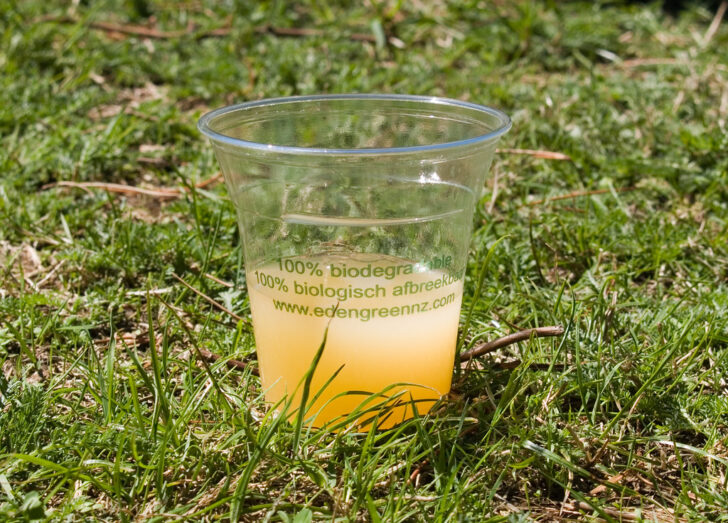Are plant-based bioplastics less harmful than conventional plastics?

So-called "bioplastics" are regarded as an environmentally friendly alternative to conventional, petroleum-based plastics, but consist of a chemical mix of up to 20,000 substances. Are these biomaterials less harmful than conventional plastics in terms of their chemical composition?
So-called "bioplastics" are regarded as an environmentally friendly alternative to conventional, petroleum-based plastics. It can be obtained from renewable raw materials or be compostable or even both. But are these biomaterials less questionable than conventional plastics in terms of their chemical composition? No, is the result of the most comprehensive laboratory study to date on this subject, published in the journal Environment International. Scientists from the PlastX research group have investigated everyday products made of different materials: The proportion of products made of biomaterials containing harmful chemicals is just as high as for products made of petroleum-based plastics.
Plastic products have come under massive criticism. Even their manufacture from fossil fuels is considered unsustainable, the global plastic waste problem is unsolved, and because of harmful substances such as bisphenol A, everyday plastic products are repeatedly hitting the headlines. In the search for alternatives, new materials are increasingly being developed that are supposed to have more advantageous ecological properties. These include bioplastics. They include biobased materials such as bio-polyethylene, which is made from renewable raw materials, and so-called biodegradable materials that are degradable under natural environmental conditions, such as polylactic acid (PLA). The new solutions also include plant-based products made of natural polymers such as cellulose. But are these biomaterials, which are marketed as a sustainable alternative to conventional plastics, less problematic in terms of their chemical composition?
Three out of four products contain chemicals that are negative in cell tests
The PlastX research group, led by ISOE - Institute for Social-Ecological Research, together with the Technical-Natural Science University of Norway and the Goethe University of Frankfurt, has investigated this question in a laboratory study. It is the most comprehensive study to date in which bioplastics and plant-based materials have been examined for their chemical composition and toxicity and compared with conventional plastics. "In order to analyze possible harmful effects of the chemical mixture, we removed the substances from the products and used them in cell tests," explains Lisa Zimmermann, the first author of the now published study. "The results show that the bio-based or biodegradable materials are by no means less of a concern. Three quarters of all products examined contained harmful chemicals," says Zimmermann. "Harmful in this case means that substances have a toxic effect on cells or cause hormone-like effects. We came to the same conclusion with conventional plastics; here, too, three out of four products tested contained harmful chemicals in this sense".
Chemical mix of up to 20'000 substances in biomaterials
Among the 43 bio-based and biodegradable products studied were disposable tableware, chocolate packaging, drinking bottles, wine corks and cigarette filters. The examination of the chemical mixtures by means of chemical analysis showed that 80 percent of the products contained more than a thousand substances, in some products even up to 20,000. "The plant-based products made of cellulose or starch contained the most chemicals. These were also the most toxic, i.e. had negative effects in cell tests," explains the ecotoxicologist.
From raw material to end product: overall toxicity increases
On the one hand, the study revealed that the end products examined contained a wider range of substances and were more toxic than the raw materials from which they were manufactured. This is because new substances are added or formed during the processing of the raw material to the end product. On the other hand, each bio-based and biodegradable product had an "individual" chemical composition. "This makes it almost impossible to make generally valid statements about the safety of certain materials," explains co-author Martin Wagner from the University of Trondheim. "A food-safe bag made of bio-polyethylene may contain toxic substances, a wine cork made of the same material does not necessarily have to, and vice versa".
Chemical safety of plastics should be put on the political agenda
The study results show: "It is not comprehensible for consumers* whether they come into contact with dubious plastics in everyday life - whether conventional or "organic", says Carolin Völker, who heads the PlastX research group. The ecotoxicologist therefore advocates that the harmlessness of the substances used should be guaranteed and thus taken into account in the development of new materials. "Precisely because there is a trend towards biomaterials, it is now important to put the chemical safety of conventional plastics as well as bio-based and biodegradable alternatives on the political agenda," says Völker. Since it is not yet known what concrete effects the mix of chemicals in plastics will have on humans and nature, further studies are urgently needed in the course of risk research on plastics and their alternatives. Cell tests would provide initial indications, but are not sufficient on their own to comprehensively determine the health and environmental effects. "In order to develop really holistically better alternatives to conventional plastics, ecological and social aspects, such as greenhouse gas emissions, competition with food production and recyclability, must also be taken into account in addition to chemical safety". Here, too, "bioplastics" still have a lot of room for improvement, says Völker.
Original publication: Environment International – Are bioplastics and plant-based materials safer than conventional plastics? In vitro toxicity and chemical composition
Source: Chemie.de – Ist Bioplastik auf pflanzlicher Basis weniger bedenklich als herkömmlicher Kunststoff?
Image Source: Rebecca Cox